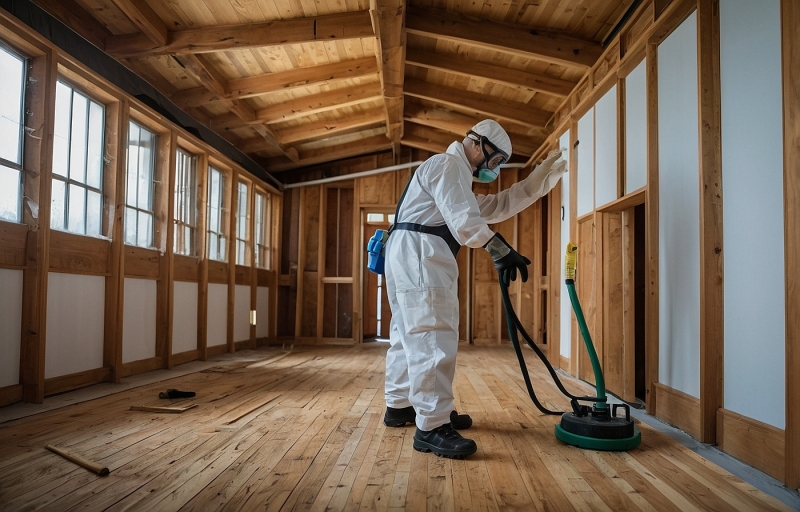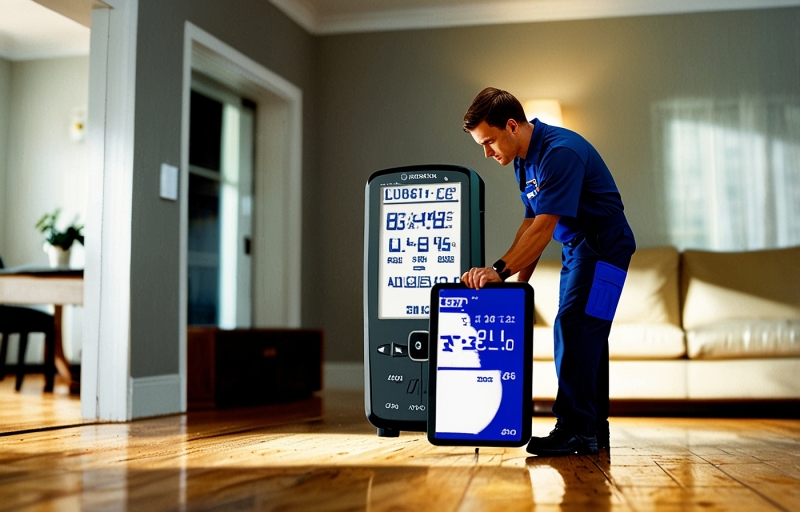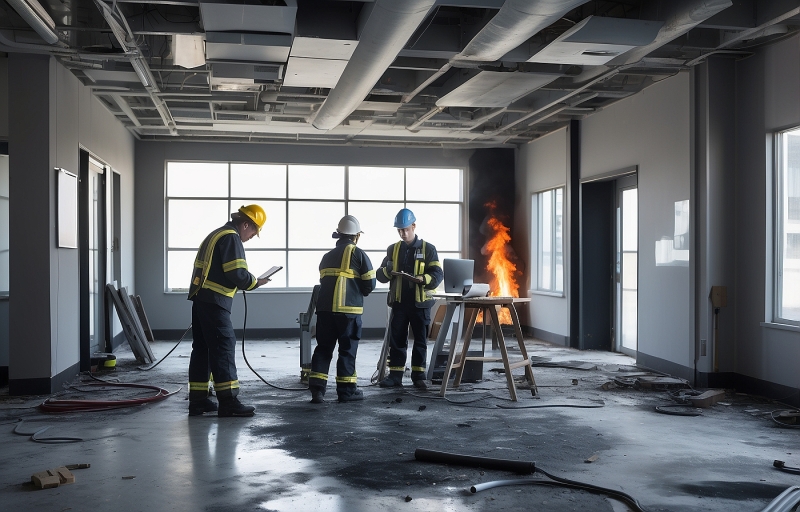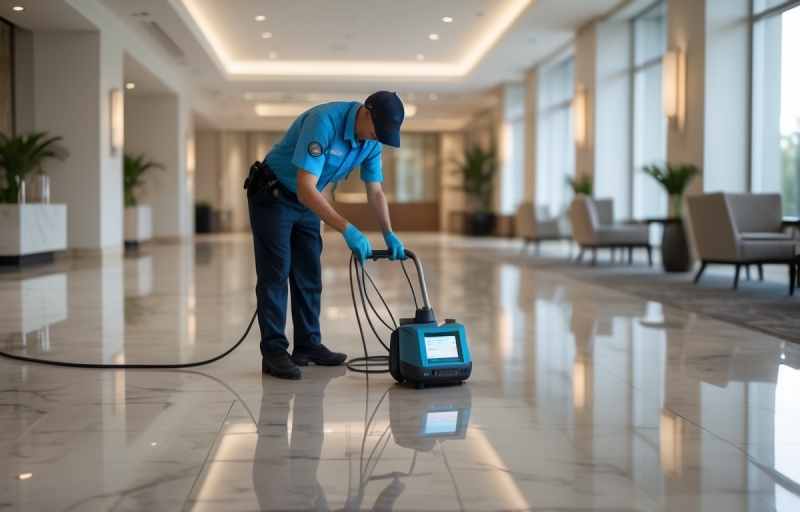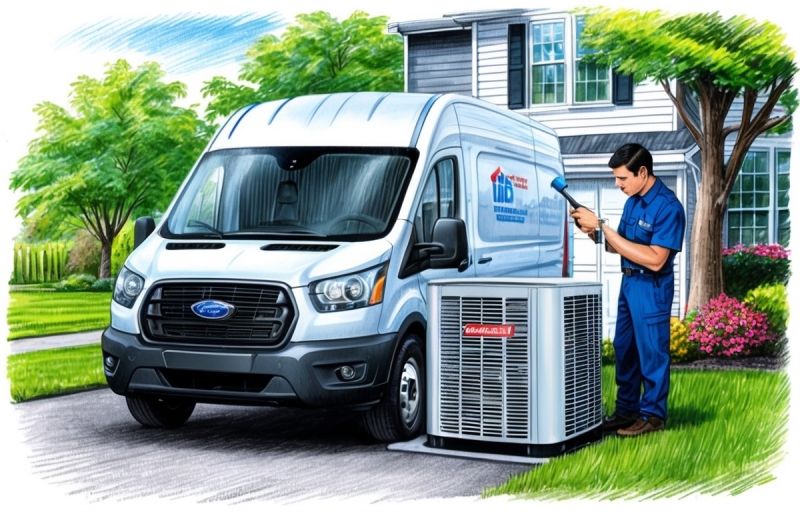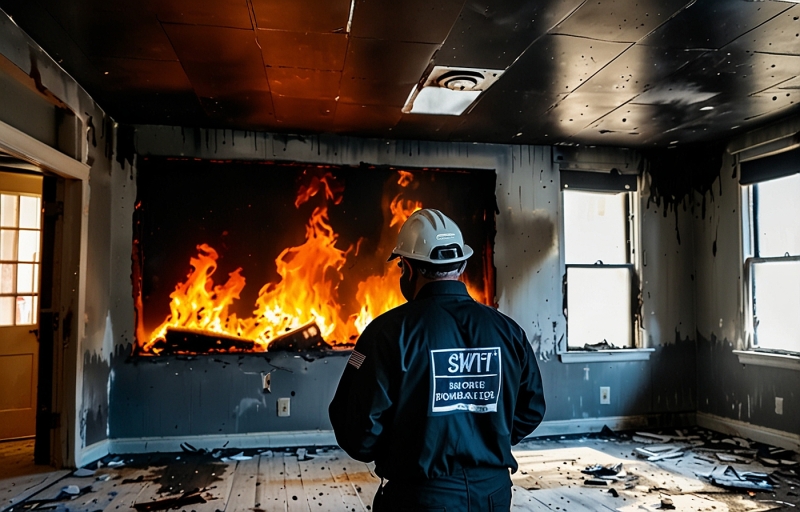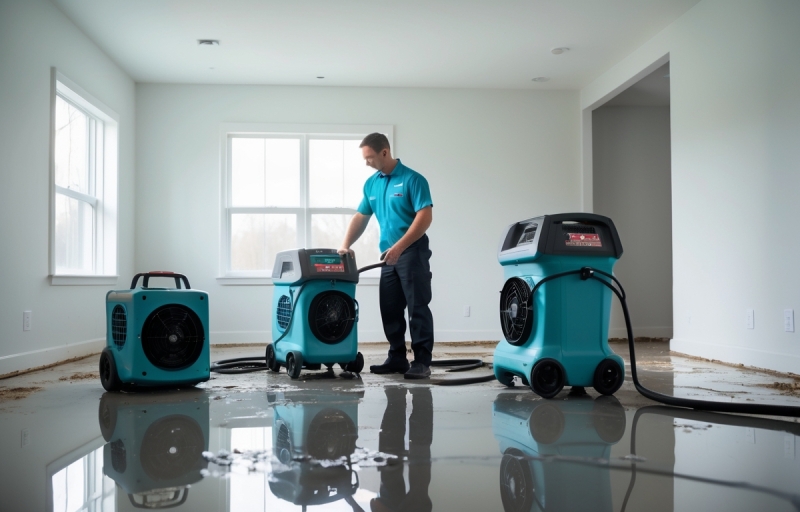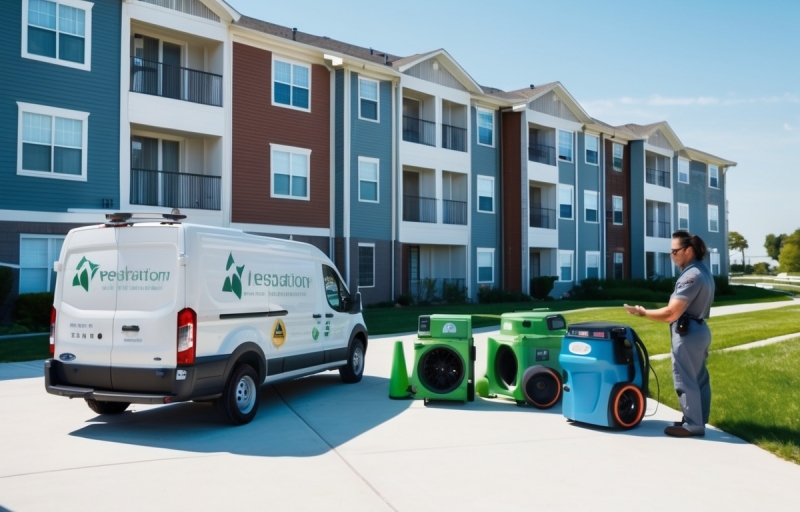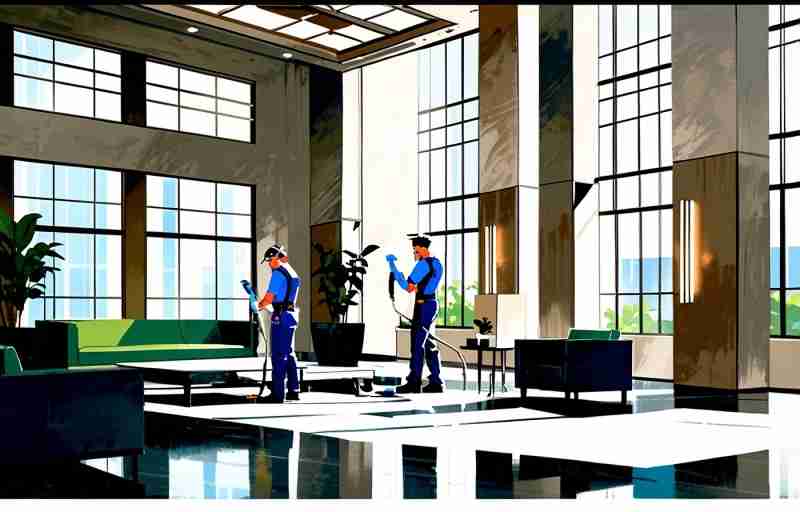When your HVAC system fails, it can quickly lead to moisture buildup — creating the perfect environment for mold growth. Knowing how to prevent mold after HVAC system failures is crucial to protecting your home and your health. At COMMITTED TO QUALITY SERVICE, we understand the urgency of addressing water damage and mold issues promptly. Our team offers fast, friendly, and professional service to help you recover quickly. Call Us Now! 855-933-7935 for expert assistance.
Water damage restoration requires specialized equipment and techniques to properly dry out structures and prevent long-term issues like mold infestation. Whether you’re dealing with water damage, fire damage, or both, immediate action is key to minimizing the impact. Mold prevention after HVAC failures involves quick moisture control, thorough inspections, and professional drying services. Trust COMMITTED TO QUALITY SERVICE to deliver the expertise you need to keep your home safe and mold-free.
Understanding the Link Between HVAC Failures and Mold Growth
When an HVAC system fails, it can create the perfect environment for mold growth, leading to serious health risks and costly property damage. Understanding how HVAC failures contribute to mold infestations is crucial for homeowners and property managers who want to protect their indoor spaces. HVAC systems are designed to regulate temperature, humidity, and air circulation. When they malfunction, these critical functions are disrupted, often resulting in excess moisture buildup, stagnant air, and temperature fluctuations, all of which are ideal conditions for mold to thrive.
One of the primary ways HVAC failures lead to mold growth is through moisture accumulation. When an air conditioner or heating system breaks down, condensation can form inside the ducts, vents, and other components. According to the Environmental Protection Agency (EPA), mold can begin to grow within 24 to 48 hours in moist conditions. This rapid growth underscores the importance of addressing HVAC issues immediately to prevent mold from taking hold.
Another contributing factor is poor ventilation. A properly functioning HVAC system ensures that air circulates efficiently throughout a building, helping to control humidity levels. When the system fails, areas of the home can become stagnant, trapping moisture and creating pockets where mold spores can settle and multiply. This is particularly problematic in hidden spaces like behind walls, under floors, and inside ceilings, where mold can grow unnoticed for extended periods.
Temperature control is another critical aspect. Mold tends to grow best in warm, humid environments. If an HVAC system fails during the summer months, indoor temperatures can rise significantly, creating an even more favorable environment for mold. Conversely, during colder months, a malfunctioning heating system can cause condensation on cold surfaces, again providing the moisture mold needs to grow.
It is also important to consider the role of dirty or clogged HVAC components. Filters, coils, and ducts that are not regularly cleaned can harbor dust, debris, and moisture, all of which can feed mold growth. In fact, the National Air Duct Cleaners Association (NADCA) recommends having HVAC systems inspected and cleaned regularly to prevent such issues.
Here are some common HVAC failures that can lead to mold problems:
- Clogged or leaking condensate drain lines
- Frozen evaporator coils
- Broken or malfunctioning dehumidifiers
- Blocked air filters and vents
- Improperly sized HVAC units that do not effectively regulate humidity
Each of these failures can create conditions that allow mold to flourish if not addressed promptly. For instance, a clogged condensate drain line can cause water to back up into the system, leading to leaks and moisture accumulation in hidden areas.
"Moisture control is the key to mold control," according to the Centers for Disease Control and Prevention (CDC). "When water leaks or spills occur indoors, act quickly. If wet or damp materials or areas are dried 24 to 48 hours after a leak
Common Causes of HVAC System Failures
HVAC system failures can occur for a variety of reasons, and understanding these causes is crucial for preventing further issues like mold growth. One of the most common causes is poor maintenance. When HVAC systems are not regularly inspected, cleaned, and serviced, dust, debris, and moisture can accumulate within the system. This buildup not only reduces efficiency but also creates an ideal environment for mold to thrive. Another frequent cause is clogged or dirty filters. Filters are designed to trap dust and allergens, but when they become clogged, airflow is restricted, leading to excess moisture and potential system breakdowns. Mechanical wear and tear is another significant factor. Over time, components such as belts, bearings, and motors can degrade, causing the system to operate inefficiently or fail altogether. Electrical issues, including faulty wiring or failing capacitors, can also lead to sudden HVAC malfunctions, often resulting in water leaks that contribute to mold problems.
Improper installation is another major contributor to HVAC system failures. If an HVAC system is not installed correctly, it may not drain properly, leading to water accumulation and increased humidity levels. This excess moisture can quickly lead to mold growth, especially in hidden areas. Additionally, refrigerant leaks are a common issue that not only reduce the system’s cooling efficiency but also introduce moisture into the air, creating a breeding ground for mold. Thermostat problems can also cause HVAC systems to cycle improperly, leading to inconsistent temperatures and humidity levels that promote mold development. Furthermore, blocked or leaky ductwork can cause uneven air distribution and moisture buildup, both of which can compromise indoor air quality and encourage mold growth.
Environmental factors also play a significant role in HVAC system failures. High humidity levels, especially in regions prone to damp weather, can overwhelm an HVAC system, making it difficult to maintain proper indoor humidity levels. This can lead to condensation within the system and, eventually, mold growth. Power surges and outages can also damage sensitive HVAC components, leading to system failures that may go unnoticed until mold becomes a visible problem. In some cases, pests such as rodents or insects can infiltrate HVAC systems, causing physical damage to wiring and insulation, which can result in malfunctions and moisture issues.
Neglecting to address minor issues promptly can escalate into major failures. For instance, a small refrigerant leak might seem insignificant at first but can lead to compressor failure if left unattended. Similarly, ignoring unusual noises or odors coming from the HVAC system can allow problems to worsen over time. Regular inspections and maintenance are essential to catch these issues early and prevent costly repairs and mold infestations. Homeowners and property managers should consider scheduling professional HVAC maintenance services to ensure their systems are operating efficiently and to identify potential problems before they lead to system failure.
At Projekt Restoration, we understand the importance of maintaining a healthy indoor environment. Our team offers comprehensive services designed to address HVAC-related issues and prevent mold growth. We also provide expert mold remediation solutions to help you restore your property quickly and effectively. If you are concerned about potential HVAC system failures or suspect mold growth in your home or business, do not hesitate to reach out to us. Visit our contact page to get in touch with our experienced team and learn more about how we can assist you in maintaining a safe and healthy environment.
Signs of Mold Development After an HVAC Breakdown
When an HVAC system fails, it can create the perfect environment for mold growth, especially if the breakdown leads to excess moisture or humidity inside your home or business. Recognizing the early signs of mold development is crucial to prevent extensive damage and costly repairs. One of the first indicators is a musty or earthy odor that lingers in the air. This smell often intensifies when the HVAC system is running, as spores are circulated throughout the property. Visible signs of mold include dark spots or patches on walls, ceilings, vents, and around the HVAC unit itself. These patches can appear black, green, or even white, depending on the type of mold. In addition to visual and olfactory clues, you might notice an increase in allergy-like symptoms among occupants, such as sneezing, coughing, itchy eyes, or respiratory issues, which can worsen over time if mold is present.
Another warning sign is the presence of condensation around windows, walls, or ductwork. Excess moisture is a breeding ground for mold, and condensation often signals that humidity levels are too high, possibly due to the HVAC system’s failure to regulate indoor air properly. Peeling paint or wallpaper, warped wood, and bubbling surfaces are also physical signs that moisture and mold may be lurking behind the scenes. If you notice any of these symptoms, it is essential to act quickly. Professional inspections and mold testing can confirm the presence of mold and help determine the extent of the infestation.
At Projekt Restoration, we understand the urgency of addressing mold issues promptly. Our comprehensive services are designed to tackle mold problems at their source, ensuring your property remains safe and healthy. We also offer expert mold remediation solutions to eliminate existing mold and prevent future growth. If you are unsure whether you are dealing with mold, our team can guide you through the process and answer any questions you might have. Visit our FAQ page for more information about common mold concerns and how we can assist you. Early detection and swift action are key to minimizing the impact of mold after an HVAC system failure, protecting both your property and your health.
Immediate Steps to Take After an HVAC Failure
When an HVAC system fails, acting quickly is crucial to prevent mold growth and minimize property damage. The first step is to turn off the HVAC system completely to stop the circulation of moist air, which can accelerate mold development. Next, inspect the affected areas for any visible signs of water leaks, condensation, or pooling water. If you notice any moisture, use towels, mops, or a wet-dry vacuum to remove as much water as possible. Setting up fans and dehumidifiers can help dry out the area faster, but be cautious not to spread spores if mold is already present. It is also important to lower indoor humidity levels to below 60 percent, as high humidity creates an ideal environment for mold. If you are unsure about the extent of the damage or how to proceed, contacting a professional restoration company is highly recommended. Companies like Projekt Restoration offer comprehensive services to address water damage and mold prevention effectively. Documenting the damage with photos and notes can also be helpful for insurance claims and professional assessments. Additionally, avoid using the HVAC system until it has been inspected and repaired by a qualified technician to prevent further contamination. If you suspect hidden water damage, it is wise to learn more about early detection by visiting resources like how to identify hidden water damage early. Taking immediate action not only protects your home but also ensures the health and safety of its occupants. For more information about how professional restoration works, you can explore the detailed process outlined on the how it works page. Swift and informed responses are key to minimizing the risks associated with HVAC failures and preventing costly mold remediation efforts later on.
How Moisture Control Prevents Mold Formation
Moisture control is one of the most critical factors in preventing mold growth after an HVAC system failure. When an HVAC system malfunctions, it often leads to increased humidity levels and water accumulation, creating the perfect environment for mold to thrive. Mold spores are naturally present in the air, but they require moisture to grow and spread. By effectively managing moisture levels, you can significantly reduce the risk of mold formation and protect your property from extensive damage. Proper moisture control begins with immediate action after an HVAC failure. It is essential to identify and repair any leaks or sources of water intrusion quickly. This includes checking for condensation buildup within the HVAC system, inspecting ductwork for leaks, and ensuring that drainage systems are functioning correctly. Using dehumidifiers and ensuring proper ventilation can also help maintain indoor humidity levels below 60 percent, which is crucial for mold prevention. Regular maintenance of your HVAC system plays a vital role in moisture control. Scheduling routine inspections and cleanings can help detect potential issues before they escalate into major problems. If you are unsure about the condition of your system or need professional assistance, consider exploring the services offered by experienced restoration companies. They can provide comprehensive solutions to manage moisture and prevent mold growth effectively.
In addition to addressing immediate concerns, it is important to understand the long-term strategies for moisture control. This includes improving insulation, sealing gaps around windows and doors, and using vapor barriers in areas prone to dampness. Monitoring indoor humidity with hygrometers can also provide early warnings of potential moisture problems. If you notice persistent dampness or musty odors, it may be a sign of hidden water damage. Learning how to detect these issues early can save you from costly repairs. You can find valuable tips on this topic by visiting the guide on how to identify hidden water damage early.
Another crucial aspect of moisture control is prompt water damage restoration. After an HVAC failure, any standing water or saturated materials must be dried and treated immediately to prevent mold colonization. Professional restoration teams use advanced equipment like industrial-grade dehumidifiers, air movers, and moisture meters to ensure thorough drying. They also apply antimicrobial treatments to inhibit mold growth on affected surfaces. If you are dealing with water damage, it is advisable to seek help from specialists who understand the complexities of moisture management. You can learn more about professional water damage solutions by visiting the water damage page.
Educating yourself about the causes and prevention of mold is equally important. Mold can cause serious health issues, especially for individuals with allergies, asthma, or weakened immune systems. By maintaining a dry and well-ventilated environment, you not only protect your property but also safeguard the health of its occupants. For more insights and expert advice, you can explore the informative articles available on the blog section. In conclusion, moisture control is the cornerstone of mold prevention following HVAC system failures. Through immediate action, regular maintenance, and professional support, you can effectively manage moisture levels and create an environment where mold cannot thrive. Taking these proactive steps ensures the longevity of your property and the well-being of everyone inside.
Importance of Proper Ventilation During HVAC Downtime
When an HVAC system fails, maintaining proper ventilation becomes critical to prevent mold growth and protect indoor air quality. Without the consistent airflow provided by a functioning HVAC system, moisture can accumulate in the air and on surfaces, creating the perfect environment for mold spores to thrive. Proper ventilation helps to regulate humidity levels, ensuring that excess moisture does not settle into walls, ceilings, carpets, and furniture. During HVAC downtime, it is essential to use alternative methods such as portable fans, dehumidifiers, and open windows to keep air circulating throughout the space. This proactive approach minimizes the risk of stagnant air, which can quickly lead to mold infestations if left unchecked. Additionally, using exhaust fans in kitchens and bathrooms can help expel humid air directly outside, further reducing indoor moisture levels. Homeowners and property managers should also monitor humidity with a hygrometer, aiming to keep indoor humidity below 60 percent to discourage mold growth. If you are unsure about the best practices for maintaining ventilation during an HVAC failure, consulting with professionals can make a significant difference. At Projekt Restoration, we offer a range of services designed to help you manage moisture and prevent mold issues before they escalate. Our team understands the importance of quick action and can guide you through effective strategies to safeguard your property. For those interested in learning more about our expertise and commitment to quality, visit our about page. In cases where water damage has already occurred due to HVAC issues, immediate intervention is crucial. Our specialized water damage restoration services can help mitigate the risks and restore your home or business to a safe, healthy condition. Proper ventilation during HVAC downtime is not just a temporary fix but a vital step in maintaining a mold-free environment and ensuring the long-term health of your indoor spaces.
Using Dehumidifiers to Combat Excess Moisture
One of the most effective ways to prevent mold growth after an HVAC system failure is by using dehumidifiers to control excess moisture. When an HVAC system fails, it can lead to increased humidity levels inside your home or building, creating the perfect environment for mold to thrive. Dehumidifiers work by extracting moisture from the air, helping to maintain an optimal indoor humidity level of around 30 to 50 percent. This significantly reduces the chances of mold spores settling and growing on surfaces such as walls, ceilings, and floors. It is crucial to act quickly after an HVAC failure because mold can begin to develop within 24 to 48 hours in damp conditions. By deploying dehumidifiers immediately, you can stabilize the indoor environment and minimize the risk of extensive mold damage. Choosing the right size and type of dehumidifier is essential for effective moisture control. For larger spaces or severe moisture problems, commercial-grade dehumidifiers may be necessary. Additionally, placing dehumidifiers in strategic locations, such as near the HVAC system, in basements, or in areas with visible water damage, can enhance their effectiveness. Regular monitoring of humidity levels with a hygrometer can also help ensure that the indoor environment remains within a safe range. If you are unsure about the extent of moisture damage or the best approach to moisture control, consulting with professionals can provide peace of mind. Companies like Projekt Restoration offer comprehensive services to assist with water damage and mold prevention. Their team can assess the situation, recommend the appropriate equipment, and even provide full restoration solutions if needed. Furthermore, understanding the early signs of hidden water damage can be crucial in preventing mold issues before they escalate. You can learn more about this by visiting their guide on how to identify hidden water damage early. In addition to using dehumidifiers, it is important to address the root cause of the moisture problem. Repairing the HVAC system promptly, fixing leaks, and ensuring proper ventilation are all critical steps in maintaining a dry and healthy indoor environment. For those seeking more information or needing immediate assistance, Projekt Restoration provides detailed insights and support through their contact page, where you can reach out to their experienced team for help. By taking proactive measures and utilizing dehumidifiers effectively, you can protect your property from the costly and hazardous effects of mold growth following an HVAC system failure.
Inspecting and Cleaning Ductwork After a System Failure
After an HVAC system failure, one of the most critical steps to prevent mold growth is thoroughly inspecting and cleaning the ductwork. When a system fails, moisture can accumulate within the ducts, creating an ideal environment for mold spores to thrive. The first step in addressing this issue is to conduct a comprehensive inspection of the entire duct system. This involves checking for visible signs of mold, such as discoloration, musty odors, or water stains. It is also important to look for hidden moisture pockets that may not be immediately apparent. Using specialized tools like moisture meters and borescopes can help identify areas that are at risk but not visible to the naked eye. If you are unsure about how to properly inspect your ductwork, it is highly recommended to consult with professionals who specialize in HVAC system restoration and mold prevention. You can learn more about professional services by visiting our services page.
Once the inspection is complete, the next step is to clean the ductwork thoroughly. Cleaning should be done using industry-approved methods to ensure that all mold spores, dust, and debris are effectively removed. This often involves using high-powered vacuums equipped with HEPA filters, as well as specialized brushes designed to scrub the interior surfaces of the ducts. In some cases, antimicrobial treatments may be applied to prevent future mold growth. It is crucial to ensure that the cleaning process is meticulous because any leftover contaminants can quickly lead to a recurrence of mold problems. If the ductwork is severely contaminated or damaged, it may be necessary to replace certain sections to maintain indoor air quality and system efficiency.
In addition to cleaning, it is essential to address the root cause of the HVAC failure to prevent future issues. This might involve repairing leaks, improving drainage systems, or upgrading insulation around the ductwork. Regular maintenance and prompt repairs can significantly reduce the risk of moisture buildup and subsequent mold growth. For homeowners and property managers looking to understand more about moisture-related issues, our detailed guide on how to identify hidden water damage early offers valuable insights.
Proper documentation of the inspection and cleaning process is also important, especially for insurance purposes or future property sales. Keeping a record of the steps taken to remediate the system can provide peace of mind and demonstrate a proactive approach to property maintenance. Additionally, scheduling periodic inspections even after the initial cleaning can help catch any new issues before they escalate into major problems.
If you are dealing with the aftermath of an HVAC system failure and are concerned about mold, reaching out to experienced professionals can make all the difference. At Projekt Restoration, we are committed to helping you protect your property and health. Learn more about our team and mission by visiting our our mission page. Taking swift and thorough action after a system failure is key to maintaining a safe and healthy indoor environment.
How to Dry Out Affected Areas Quickly and Effectively
When an HVAC system fails, it can lead to significant moisture buildup, creating the perfect environment for mold growth. Acting quickly to dry out affected areas is crucial to prevent further damage and protect your indoor air quality. The first step is to immediately turn off the HVAC system to stop the spread of moisture throughout the property. Open all windows and doors to promote natural ventilation, allowing fresh air to circulate and help dry out the space. Using high-powered fans and industrial-grade dehumidifiers can significantly speed up the drying process. Position fans to blow air across wet surfaces and direct moisture toward open windows or exhaust vents. Dehumidifiers should be placed in the center of the affected area to pull moisture from the air efficiently. It is important to monitor humidity levels with a hygrometer, aiming to keep indoor humidity below 50 percent to inhibit mold growth. Removing water-damaged materials such as carpets, insulation, and drywall is often necessary, as these materials can retain moisture and become breeding grounds for mold. If the damage is extensive, it is wise to seek professional help. Companies like Projekt Restoration offer specialized drying and restoration services to ensure your property is properly treated. Additionally, inspecting hidden areas such as behind walls, under flooring, and inside ductwork is essential, as moisture can linger in these spaces unnoticed. Using infrared cameras and moisture meters can help detect hidden dampness that might otherwise be missed. For those interested in learning more about early detection, our guide on how to identify hidden water damage early provides valuable insights. It is also beneficial to remove any furniture or belongings from the affected area to allow for better airflow and prevent further contamination. Cleaning and disinfecting surfaces with antimicrobial solutions can help eliminate any mold spores that may have already started to develop. Regularly checking the progress of the drying process is important, and adjustments should be made as needed to ensure complete moisture removal. If you are unsure about the extent of the damage or the best course of action, consulting with experts through our contact page can provide you with professional guidance and peace of mind. Taking swift and thorough action to dry out affected areas not only helps prevent mold but also protects the structural integrity of your home or business, ensuring a safe and healthy environment for everyone.
Choosing Mold-Resistant Materials for Repairs
When repairing areas affected by HVAC system failures, selecting the right materials is crucial to prevent future mold growth. Mold thrives in damp, organic environments, so choosing mold-resistant materials can significantly reduce the risk of recurrence. Start by opting for mold-resistant drywall, often referred to as green board or purple board, which is specially treated to resist moisture absorption. Unlike traditional drywall, these alternatives are designed to withstand humid conditions, making them ideal for spaces like basements, attics, and areas around HVAC systems. Similarly, when replacing insulation, consider using closed-cell spray foam or fiberglass insulation with a vapor barrier, both of which are less susceptible to mold compared to traditional cellulose insulation. Flooring choices also play a vital role; materials like ceramic tile, vinyl, and sealed concrete are excellent options because they do not retain moisture and are easy to clean. For paints and coatings, use mold-inhibiting primers and paints that contain antimicrobial agents, providing an extra layer of defense against mold spores. Additionally, when selecting wood products, opt for pressure-treated or composite wood, which is more resistant to moisture and fungal growth than untreated wood. It is also essential to ensure that all materials are installed correctly and that the area is properly ventilated to maintain low humidity levels. Working with experienced professionals who understand the importance of using mold-resistant materials can make a significant difference. You can learn more about professional services by visiting our services page. If you are curious about the broader steps involved in protecting your property, our detailed how it works guide offers valuable insights. Moreover, if you suspect hidden water damage that could lead to mold issues, our resource on how to identify hidden water damage early can help you take proactive measures. By carefully selecting the right materials and ensuring proper installation, you can create a more resilient environment that minimizes the risk of mold growth after HVAC system failures.
When to Call a Professional Mold Remediation Service
If you have experienced an HVAC system failure, it is crucial to act quickly to prevent mold growth. However, there are situations when DIY efforts are not enough, and calling a professional mold remediation service becomes necessary. One clear sign that you need expert help is the presence of visible mold spreading across walls, ceilings, or around vents. Mold can grow rapidly in moist environments, and HVAC failures often create the perfect conditions for it to thrive. If you notice a persistent musty odor that does not go away even after cleaning, it could indicate hidden mold colonies that require professional inspection and removal. Additionally, if anyone in your household is experiencing unexplained allergies, respiratory issues, or worsening asthma symptoms, it is a strong indication that mold may be affecting your indoor air quality. In such cases, contacting a trusted company like Projekt Restoration is essential to ensure a thorough and safe remediation process.
Another reason to seek professional help is when the affected area is extensive. According to industry standards, if the mold covers an area larger than 10 square feet, it is recommended to hire certified mold remediation specialists. Large infestations often involve complex issues like structural damage, contaminated HVAC components, and hidden moisture pockets that only trained professionals can properly address. Attempting to clean large mold problems without the right equipment and expertise can worsen the situation and pose serious health risks. Professionals use specialized tools such as HEPA vacuums, air scrubbers, and moisture meters to detect and eliminate mold at its source. They also follow strict containment procedures to prevent cross-contamination to unaffected areas of your home or business.
If your HVAC system failure resulted in significant water damage, it is another strong reason to call in the experts. Water damage can seep into walls, floors, and ductwork, creating hidden breeding grounds for mold. A professional team can assess the full extent of the water intrusion and implement a comprehensive plan to dry, clean, and restore the affected areas. You can learn more about how we handle such situations by visiting our water damage page. Immediate professional intervention not only prevents mold growth but also protects the structural integrity of your property and saves you from costly repairs down the line.
Moreover, if you are unsure about the extent of the mold problem or how to properly address it, consulting with a professional is the safest choice. Experts can perform detailed inspections using advanced technology to locate hidden mold and moisture sources. They can also provide you with a clear remediation plan tailored to your specific situation. At Projekt Restoration, we pride ourselves on offering comprehensive services that cover every aspect of mold removal, from initial assessment to final clearance testing. Our team is trained to follow industry best practices and comply with all health and safety regulations, ensuring that your home or business is restored to a safe and healthy environment.
In some cases, insurance companies may require professional documentation of the mold damage and remediation efforts for claims processing. Hiring a certified mold remediation company ensures that you have the necessary reports and evidence to support your insurance claim. This can significantly ease the financial burden of repairs and restoration. If you have questions about how the process works, you can visit our FAQ page for more information.
Finally, peace of mind is invaluable when dealing with mold issues after an HVAC system failure. Knowing that trained professionals are handling the situation allows you to focus on other important matters without the stress and uncertainty of tackling mold on your own. Whether you are dealing with a minor mold issue or a major infestation, reaching out to a reputable company like Projekt Restoration ensures that the job is done right the first time. Our commitment to excellence and customer satisfaction is reflected in every project we undertake. If you would like to learn more about who we are and what drives us, feel free to visit our about page. Taking swift and decisive action by calling a professional mold remediation service can make all the difference in protecting your property and your health after an HVAC system failure.
Preventative Maintenance Tips for Your HVAC System
Regular preventative maintenance is crucial for keeping your HVAC system running efficiently and for preventing mold growth after any system failures. One of the first steps is to schedule professional inspections at least twice a year, ideally before the summer and winter seasons when your system is under the most stress. During these inspections, technicians can identify potential issues such as clogged drains, dirty coils, or malfunctioning components that could lead to moisture buildup and mold formation. Homeowners should also make it a habit to replace air filters every one to three months. Dirty filters restrict airflow, causing the system to work harder and potentially leading to condensation problems that create an ideal environment for mold. Cleaning the evaporator and condenser coils regularly is another important task, as dirt and debris can trap moisture and encourage mold growth. Additionally, ensure that the condensate drain line is clear and flowing properly to prevent water from backing up into the system.
Maintaining proper humidity levels inside your home is another key factor. Ideally, indoor humidity should be kept between 30 and 50 percent. Using a dehumidifier in particularly humid areas or during damp seasons can help maintain these levels. Sealing any leaks in your ductwork is also critical, as leaks can introduce moisture and contaminants into the system, promoting mold growth. Homeowners should also pay attention to any unusual odors or visible signs of moisture around vents and registers, as these can be early indicators of mold issues. If you notice any signs of water damage, it is important to address them immediately. For more information on identifying hidden water issues, you can refer to our detailed guide on how to identify hidden water damage early.
Another important aspect of preventative maintenance is ensuring that your HVAC system is properly sized for your home. An oversized or undersized system can lead to inefficient operation and increased moisture levels, both of which can contribute to mold problems. Consulting with a professional HVAC technician can help you determine if your system is appropriately sized and functioning optimally. It is also beneficial to understand the services available for maintaining and restoring your HVAC system. You can explore our range of services to learn how we can assist with HVAC maintenance and mold prevention.
In addition to professional maintenance, homeowners should be proactive about keeping the areas around their HVAC units clean and dry. Ensure that outdoor units are free from debris like leaves, grass, and dirt, which can block airflow and trap moisture. Indoor units should also be kept clear of dust and clutter. Regularly inspecting insulation around ducts and pipes can prevent condensation and subsequent mold growth. If insulation becomes wet or damaged, it should be replaced promptly.
Educating yourself about the potential risks and signs of mold can also empower you to act quickly if problems arise. Our blog offers valuable insights and tips on mold prevention and HVAC maintenance. By staying informed and taking a proactive approach to HVAC care, you can significantly reduce the risk of mold developing after system failures. Preventative maintenance not only extends the life of your HVAC system but also protects your home and health from the dangers of mold.
Long-Term Strategies to Protect Your Home from Mold
Preventing mold growth after an HVAC system failure requires more than just immediate cleanup; it demands a comprehensive long-term strategy to safeguard your home. One of the most effective ways to protect your property is by maintaining consistent indoor humidity levels. Ideally, indoor humidity should stay between 30 to 50 percent. Investing in a high-quality dehumidifier and using a hygrometer to monitor moisture levels can help you achieve this balance. Regular HVAC maintenance is equally crucial. Scheduling professional inspections and cleanings at least twice a year ensures that your system operates efficiently and does not contribute to moisture buildup. Additionally, it is important to address any water leaks immediately, whether they stem from plumbing issues, roof damage, or foundation cracks. Ignoring even minor leaks can create the perfect environment for mold to thrive. Homeowners should also consider upgrading insulation and sealing windows and doors properly to prevent condensation and moisture intrusion.
Another critical step is to improve ventilation throughout your home. Areas like bathrooms, kitchens, and laundry rooms are particularly prone to moisture accumulation. Installing exhaust fans and ensuring they vent to the outside, not just into the attic, can significantly reduce the risk of mold. For those who have experienced water damage due to HVAC failures, it is advisable to seek professional help. Companies like Projekt Restoration offer specialized water damage services that can thoroughly dry and restore affected areas, minimizing the chance of mold development. Regularly inspecting hidden areas such as behind walls, under sinks, and in basements can also help catch early signs of moisture problems before they escalate.
Incorporating mold-resistant products during home renovations is another proactive measure. Materials such as mold-resistant drywall, paints, and insulation can provide an extra layer of protection. It is also beneficial to educate yourself about the signs of hidden water damage by visiting resources like how to identify hidden water damage early. This knowledge empowers homeowners to act swiftly at the first indication of trouble. Moreover, establishing a relationship with a trusted restoration company ensures you have expert support readily available. Projekt Restoration offers a wide range of services designed to help homeowners recover from disasters and prevent future issues.
Finally, maintaining a clean and clutter-free environment can also deter mold growth. Dust and organic debris can trap moisture and provide a food source for mold spores. Regular cleaning, especially in less frequently used areas like attics and crawl spaces, can make a significant difference. By implementing these long-term strategies, homeowners can create a resilient defense against mold, ensuring a healthier and safer living environment even after HVAC system failures.
Creating an Emergency Response Plan for Future HVAC Issues
When it comes to preventing mold after HVAC system failures, having a well-thought-out emergency response plan is crucial. A prompt and organized reaction can significantly reduce the risk of mold growth, which thrives in moist environments often created by HVAC malfunctions. The first step in creating an effective emergency response plan is to identify potential risks associated with your HVAC system. This includes understanding the age of the system, previous maintenance issues, and any history of leaks or water damage. Regular inspections and maintenance schedules should be part of this plan to catch minor problems before they escalate. It is also important to educate everyone in the household or building about the signs of HVAC failure, such as unusual noises, inconsistent temperatures, or visible moisture around vents and ducts.
In the event of an HVAC failure, the plan should outline immediate actions to take. This includes shutting down the system to prevent further water leakage, using dehumidifiers to control moisture levels, and contacting a professional restoration service without delay. Having a trusted restoration partner on speed dial can make a significant difference. Companies like Projekt Restoration offer comprehensive services that include emergency water extraction, drying, and mold remediation. It is also wise to have a list of emergency contacts, including HVAC technicians, electricians, and water damage specialists, readily available.
Documentation is another critical component of an emergency response plan. Keep detailed records of all HVAC maintenance, repairs, and inspections. In case of a failure, document the damage with photographs and notes, which can be invaluable for insurance claims and professional assessments. Additionally, understanding your insurance policy and what it covers regarding HVAC failures and subsequent mold damage is essential. If you are unsure about the specifics, consulting the FAQ section of trusted restoration companies can provide clarity and guidance.
Training and drills are often overlooked but are vital for ensuring everyone knows their role during an HVAC emergency. Conducting periodic drills can help reinforce the steps to take and reduce panic during an actual event. For businesses, assigning specific roles to employees, such as who contacts the restoration company or who manages internal communications, can streamline the response process. Homeowners can benefit from family meetings to discuss the plan and ensure everyone understands the importance of quick action to prevent mold growth.
Another important aspect is having access to resources and educational materials about mold prevention and HVAC maintenance. Regularly reading expert advice, such as the articles found on the blog of reputable restoration companies, can keep you informed about the latest best practices and technologies. Staying proactive by learning about early signs of hidden water damage, for instance, can help you address issues before they lead to significant mold problems.
Finally, it is beneficial to review and update your emergency response plan annually or after any significant changes to your HVAC system or property structure. This ensures that the plan remains relevant and effective. By taking these proactive steps, you can minimize the risk of mold growth following HVAC system failures and protect the health and safety of everyone in the building.
Of course! Here’s a suitable FAQ section for a blog on "How to Prevent Mold After HVAC System Failures," based on the information we’ve discussed:
FAQ: Preventing Mold After HVAC System Failures
Q1: Why does mold become a problem after an HVAC system failure?
A: When an HVAC system fails, it can lead to excess moisture buildup due to poor ventilation, leaks, or condensation. Mold thrives in damp, humid environments, so without proper airflow and dehumidification, mold can quickly grow on surfaces like walls, ceilings, and inside ductwork.
Q2: What are the first steps I should take after an HVAC failure to prevent mold?
A: Immediately address any standing water or visible moisture. Use fans, dehumidifiers, and open windows (if weather permits) to dry out the area. It’s also important to inspect for leaks and repair them promptly. Acting quickly within the first 24-48 hours is crucial to prevent mold growth.
Q3: How can I control humidity levels after an HVAC failure?
A: Use portable dehumidifiers to maintain indoor humidity below 60%, ideally between 30-50%. Monitor humidity with a hygrometer. If the HVAC system is still down, ensure good air circulation with fans and by opening doors and windows when possible.
Q4: Should I clean HVAC components after a failure?
A: Yes. Once the system is repaired, clean and inspect components like ductwork, coils, and drip pans. Mold can hide in these areas and continue to spread if not properly cleaned. In some cases, professional duct cleaning may be necessary.
Q5: When should I call a professional for mold prevention or remediation?
A: If you notice visible mold growth, musty odors, or if the affected area is larger than 10 square feet, it’s best to call a mold remediation specialist. Professionals can safely remove mold and prevent it from returning.
Q6: Can regular HVAC maintenance help prevent mold in the future?
A: Absolutely. Regular maintenance, including changing filters, cleaning coils, checking for leaks, and ensuring proper drainage, can significantly reduce the risk of mold growth. Schedule professional inspections at least once a year.
Q7: What materials are most at risk for mold after an HVAC failure?
A: Porous materials like drywall, insulation, carpeting, and ceiling tiles are especially vulnerable. If these materials become saturated and aren’t dried quickly, they may need to be removed and replaced to prevent mold.
Q8: How long does it take for mold to start growing after moisture exposure?
A: Mold can begin growing within 24 to 48 hours of moisture exposure. That’s why it’s critical to act quickly to dry out affected areas and control humidity.
Q9: Are there any preventive products I can use to protect against mold?
A: Yes. Mold-resistant paints, coatings, and building materials can help reduce the risk of mold growth, especially in areas prone to moisture. Additionally, installing UV lights in your HVAC system can help kill mold spores circulating through the air.
Q10: What are signs that mold might already be present after an HVAC failure?
A: Common signs include a persistent musty odor, visible discoloration on walls or ceilings, increased allergy symptoms, and respiratory issues. If you notice any of these signs, it’s important to investigate further and take action.
Would you also like a short introduction and conclusion for the FAQ section to make it even more polished for your blog?

